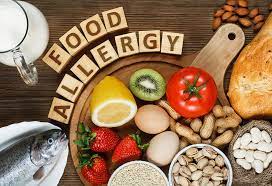Food Allergy or Oral Allergy Syndrome? Learn the Difference.
Food Allergy or Oral Allergy Syndrome? Learn the Difference.
Mouth itching and tingling can be due to two different allergy-related
conditions. Before you self-diagnose or avoid food groups altogether, know the
difference between food allergy and Oral Allergy Syndrome (OAS).
Food Allergy
A food allergy is diagnosed by patient history, skin prick testing and blood
testing to determine true age response to specific foods.
To cause a reaction, the food must first go through the digestive system.
Touching or smelling the food won’t typically cause a reaction. Reactions can
be mild like mouth itching and tingling, but can also be very severe,
presenting symptoms throughout the entire body, including anaphylaxis.
Reactions can occur up to 2 hours after eating the food, and other people have
delayed reactions 4-6 hours after ingesting the food
Oral Allergy Syndrome (OAS)
For people with an environmental allergy – like tree, grass, or a weed –
they can experience reactions to certain raw fruits and vegetables. OAS isn’t a
direct reaction to a food, but a complication with underlying environmental
allergy. Because the protein structure in pollen and some foods are similar,
during peak allergy season, the body may see the similar protein structures in
raw fruits and vegetables as a threat and react.
The symptoms aren’t systemic, typically just itching or tingling in the
mouth, although some may see slightly more severe symptoms. Symptoms typically
occur fairly quick, within 5 to 30 minutes.
To avoid OAS symptoms, people can treat the cause of their environmental
allergies with sublingual immunotherapy, manage their symptoms with an
antihistamine, or cook fresh fruits and vegetables fully to break down the
problematic protein structures.
Ragweed and Oral Allergy
Syndrome
Ragweed season is slowing down across the country, but the millions of
Americans that felt symptoms with ragweed exposure this season may have also
experienced OAS. Here are the foods that typically cause reactions:
Banana
Melons (cantaloupe, honeydew, watermelon)
Peach
Cucumber
Zucchini
The biggest adjustment with food allergies, and any situation where a food
has to be eliminated, is replacing the nutrients from the foods the person is
now missing in their diet. OAS is the same way.
The foods that cause OAS symptoms for those with ragweed allergy contain
many common nutrients. If eliminating one – or more – of the foods above, try
to incorporate a few of these replacements into your meals each day:
Vitamin C: Bell peppers, citrus fruits, strawberries, kiwi
Fiber: Whole grains
Vitamin A: Sweet potato, carrot, apricot, broccoli
Manganese: Spinach
Seeking more information from a registered dietitian can help ensure your
diet is up to par amid dietary changes. You can also learn more about oral
allergy syndrome and treatment here.

.jpg)
.jpg)
Comments
Post a Comment